CNN
—
Attendance at women’s football has seen a remarkable increase in recent years and records have tumbled around the world.
At Camp Nou, Barcelona Femení set consecutive world records for most attendances at a women’s football match, with 91,648 fans watching the Catalans against VfL Wolfsberg earlier this year; The England women broke the record for the highest attendance at a Lionesses home game in 2019 with 77,768 – and even Newcastle United broke their attendance record at their first game at St James’ Park with 22,134 spectators in fourth tier English women’s football.
Demand, particularly in Europe, has never been higher, which is why the choice of stadiums to host the European Women’s Championship, which is currently taking place in England, has raised eyebrows.
Critics argue that the English Football Association (FA) and UEFA, the governing body of European football, failed to seize the opportunity.
Although the 10 venues include giants such as Wembley Stadium and Old Trafford, each hosting a game, games are also played at the 8,000-seat Leigh Sports Village Stadium and the 12,000-seat New York Stadium in Rotherham.
The smallest venue is Manchester City Academy Stadium, part of the English Premier League club’s state-of-the-art training complex with a capacity of just 4,700. As with Leigh Sports Village stadium in Greater Manchester, capacity is limited due to regulations preventing standing room.
The first of three games to be played at Manchester City Academy Stadium, home of Manchester City’s women’s team, is Belgium’s Group D game against Iceland on July 10.
In April, Juventus and Iceland midfielder Sara Björk Gunnarsdóttir told the Their Pitch podcast that she was “a little disappointed” with the choice of stadium.
“It’s shocking. When we play in England there are so many stadiums and we have a City training ground that can seat 4,000 spectators? said Gunnarsdóttir.
“It’s embarrassing. It’s not the respect (that we deserve). Look at women’s football today, they fill the stadiums. You see Barcelona and Madrid, 95,000 are watching the game (at the Camp Nou). They’re not on it prepared that we sell more than 4,000 tickets.
“It’s disrespectful to women’s football because it’s so much bigger than people think. You think women’s football takes two steps forward, but then something like this happens, it’s just one step back.”
Rachel O’Sullivan, women’s football expert and co-founder of media company Girlsontheball, said the choice of two stadiums with a capacity of less than 10,000 for a major tournament was “a bit ambitious”.
“It was kind of a habit in women’s football not to expect it to be as big and not grow as it is,” said O’Sullivan, who said she was “disappointed and surprised” when she saw the stadium choice, said CNN Sports.
“If you look at the evidence, it’s grown exponentially – and the 2019 World Cup really showed us that. Many were surprised by the numbers who wanted to start and get into football – and we shouldn’t be. We should expect that.”

Since England’s bid to host Euro 2022 four years ago, the landscape of women’s football has changed drastically.
There was a World Cup that broke attendance and attendance records – suggesting a new dawn was at hand for women’s international football – and massive advances in club sport, particularly in Europe.
The 2019 World Cup was watched by around 1.12 billion viewers across all platforms – a record audience for the competition. The USA-Netherlands final was the most-watched match of all time at a Women’s World Cup with 82.18 million live viewers, up 56% from the 2015 final.
However, when the first stadium selection process for Euro 2022 took place in 2019, the FA struggled to find viable venues as clubs and councils were reluctant to propose, FA chief executive Mark Bullingham explained last month.
“The absolute truth is we ran a bidding process in all the major stadiums and cities across the country and there have been very few who have come forward wanting to host the Women’s Euros,” Bullingham said in a Zoom interview reporters.
“We actually had to convince a couple of clubs and cities to come forward, so we’re actually really happy with what we’ve achieved.
“We think we have some brilliant venues, but if you think people are kicking down our door to host games, that wasn’t the case.”
Since 2019, women’s football has grown in revenue, fanbase and spectators, catapulting the sport into another stratosphere.
Besides Wembley (89,000), Old Trafford (74,000), Leigh Sports Village and Manchester City Academy Stadium, the other venues are Sheffield United’s Bramall Lane (30,000), Southampton’s St Mary’s Stadium (32,000), the Amex of Brighton and Hove Albion Stadium (30,000), Milton Keynes Dons’ Stadium MK (30,000), Brentford’s Brentford Community Stadium (17,000) and Rotherham United’s New York Stadium.
Women’s football author Richard Laverty said if the selection process happened now, perhaps for an upcoming World Cup, it could be a very different story.
“I think if they did it now, maybe they would choose differently. I think women’s football has gotten so big now and I think they probably underestimated the demand, maybe from traveling fans, from neutral fans, from England fans,” Laverty told CNN Sport.
Given the sport’s rapid growth, O’Sullivan suggested being ambitious was the only way forward.
“We have to expect it to grow rather than being surprised every time because if you look at the stats and the viewership over the years and at each tournament it’s just bigger and better every time. And that’s what we should strive for.”

The locations of the tournament’s stadiums have also been criticized.
Whilst there is a cluster of stadiums in the North West and South of England – including London – there are no traditional strongholds for the sport in the Midlands or the North East.
Although the unwillingness of councils and clubs to introduce themselves limited the FA’s choices, O’Sullivan said it was a “real shame” that there were no one in those regions, particularly the North East, an area with such a rich footballing history have reported.
However, the host stadiums still include four Premier League grounds, the country’s marquee – Wembley – a newer top stadium and two venues hosting Women’s Super League matches, a criterion the FA wanted to include.
And the sell-out final at Wembley Stadium is expected to be the best-attended Euro final in history, whether men or women, surpassing the current record of 79,115 set at the 1964 European Men’s Championship.
Sue Campbell, the FA’s director of women’s football, told the Independent in June that the stadium selection process is balanced and they hope to learn from it.
“So have we found the right balance? We’ll look at it again, but you’ve got a big stadium opening it, you’ve got a big stadium closing it, at Old Trafford and Wembley,” Campbell said.

“We think we’ve found the right balance. At the end we take a close look at that and check it, and that’s where we are at the moment.”
Despite the tournament having two stadiums under 10,000, UEFA told CNN it hopes it will become the “biggest European women’s sporting event in history”.
According to a UEFA spokesman, over 700,000 tickets are available for 31 matches. Up until a few days before the start of the tournament, over 500,000 tickets had been sold, a record for the Women’s Euros.
Regarding matches being played at Manchester City Academy, UEFA and the FA said the stadium will “create a great atmosphere worthy of a women’s European Championship”.
“We are confident that many games will be sold out and we look forward to more than doubling the total attendance of UEFA Women’s Euro 2017 in the Netherlands and hosting the best UEFA Women’s Euro ever,” UEFA told CNN in an email With.
At full capacity, smaller venues offer at least a better TV spectacle than empty larger arenas.
Both O’Sullivan and Laverty referenced games played at the 2019 World Cup in Nice, which were sparsely attended.
Laverty felt there was “definitely some short-sightedness” in the choice of stadiums, but said that with a good product on the pitch and full-capacity stadiums, people would forget the arguments.
“I think once the football starts and the stadiums start looking full people probably forget it quickly because on the pitch you focus on the product and I think this is going to be the best women’s Euros ever.”
